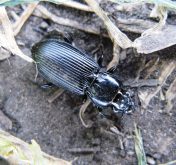The cutworms may already be out, but the damage is unlikely to look like the usual “clipped” stems, according to provincial entomologist John Gavloski.
Dingy cutworms are the only species likely to be mature enough to cause damage, as they overwinter as larvae, he said during a May 22 Crop Talk webinar. The greyish, dull-coloured pests are also known for taking chunks out of leaves, rather than clipping at the stem.
Manitoba’s other main species — redbacked and darksided cutworms, distinguished by their appropriately described streaks on the sides or back — overwinter as eggs and are more likely to cause damage later in spring.

Manitoba Agriculture has heard reports of some cutworms in the field, although not in economically threatening levels, according to Gavloski.
“At times, people can get away with just doing a patch spray in the field,” he said, adding that farmers should keep special watch on last year’s weed patches or late-flowering crops, which may have attracted the mature moths.
Farmers may also have to dig a little deeper, considering the province’s dry soil conditions. Cutworms may dive five centimetres in the soil in dry conditions, Gavloski said.




















